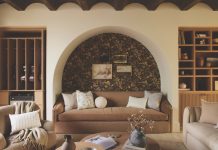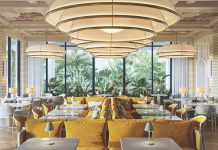By Lauren Matich
Organic is the first word that comes to mind when Kim Rodosky, co-owner of design showroom and home store 503found, assembles her picture-perfect tablescapes. The interior designer often draws inspiration from the elements—stone, wood and natural textures like linen and cotton all make their way to her spreads—but she also recognizes every design should be a reflection of its host and the guests.
For instance, a chic, adults-only New Year’s Eve table may glimmer with gold and brass accents against clean white linens and a rich accent color like teal, emerald or eggplant. But for a family-friendly affair, she suggests toying with patterns like black-and-white checkers and chalkboard details to introduce some playfulness to the tabletop.
The idea that the design should be natural to the host and his or her guests is a major part of Rodosky’s anything-goes mentality. When she discusses one of her top tips—“Use what you have”—she encourages at-home decorators to mix current trends (think black tablecloths, polished quartz and agate, and colored glass) with what’s already in their homes.
She urges hosts to consider using everything from casual ceramic dishes to the leaves and branches from the trees in their backyards. “It ends up looking natural and reflects you without looking too forced,” Rodosky comments as she recounts tables on which stacked kitchen cutting boards created centerpieces of staggering heights and candles flickered on top of simple coasters.
Personalization is another way to hit home with guests. As part of a mothers’ group, Rodosky hosted a holiday event where the place settings were marked with photographs she took of each of the kids. When the women arrived, they identified their places by finding the seat with their child’s picture.
Incorporating place cards with more than just guests’ names is the perfect opportunity to get creative.
“Say if you’re having your girlfriends over, you could do a little calligraphy message about friends or family,” she suggests. “Other things that are kind of fun are games if you want to lighten [the group] up. Maybe questions you have to answer throughout the night, funny questions to get people going.”
By this point, Rodosky’s design is usually a buzzing assortment of dishes (she recommends juxtaposing fine china with handmade pottery), vintage flatware found at flea markets, colored drinking glasses, layered tablecloths and runners, fresh branches and flowers, and objects from around the house that fit with the vibe of the party. It’s an intentional cacophony of found items, but it’s all part of the process.
Once designers can see all of the pieces arranged and working together, it’s time to refine the look. “Do your whole thing, and then pull pieces away kind of like when you’re getting dressed—how you look at yourself in the mirror and then take off something,” Rodosky advises.
Most of all, the fun that everyone will have sitting around the table should find its way into the decor and the designing process. “I think it’s always about making [the table] work for you, and not stressing about it,” Rodosky says. “Have fun with it so it represents you.”




